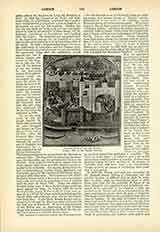

Loménie de Brienne, ETIENNE—CHARLES DE, French cardinal and statesman, b. at Paris, 1727; d. at Sens, 1794. He was of noble lineage, studied at the College d’Harcourt and then at the Sorbonne, where, in spite of certain suggestions of unorthodoxy, he was given the doctorate of theology. Ordained priest in 1752, he became successively Vicar-General of Rouen (1752), Bishop of Condom (1760), and Archbishop of Toulouse (1762). Forced by the philosophers upon Louis XVI, who feared his ambition and despised his private life, he was made in 1788 ministre principal and Archbishop of Sens, the second richest see in France. As a minister, he was popular with the Assembly of the Notables, but failed to win the Parlement over to his financial schemes, and fell after announcing the convocation of the States General for May 1, 1789. In order to offset his downfall, he succeeded by clever intrigue in gaining for himself the cardinal’s hat, and in having his nephew, Martial de Lomenie, appointed coadjutor of Sens. The influence and wealth attached to his see he used to have Sens made the seat of the new ecclesiastical department of Yonne—instead of Auxerre, the natural metropolis. Having taken the constitutional oath on January 30, 1791, he drew after him a large portion of his clergy, submitted to popular election, and, being returned both in Toulouse and Sens, chose the latter place because of its being near the French capital.
When Pius VI, by a Brief of February 23, 1791, severely rebuked him for his disloyalty, he replied by renouncing the cardinalate, and was formally deposed at the Consistory of September 26,1791. He then retired with his family to St.-Pierre-le-Vif, a confiscated abbey which he had purchased from the spoliators and shame-fully desecrated, and there awaited events. Owing to his nobility, wealth, and ecclesiastical rank, he was naturally made the object of denunciations. For a time his prodigality in bribing the local authorities saved him from harm. On November 15,1793, when the Convention was at its fiercest, and denunciations meant imminent danger, he apostatized for safety’s sake, but was nevertheless arrested on February 18, 1794. The following day he was found dead in his prison—some say from suicide, and some from a stroke of apoplexy. His nephew and former coadjutor, Martial de Lomenie, who had also apostatized, was sentenced to death on May 10, 1794, but the Christian fortitude of Madame Elisabeth and the warm exhortations of the dean of Sens, both of whom were in the same van with him, softened his heart, and he died repentant. Lomenie de Brienne was a member of the French Academy. The “Canal de Brienne” which connects the river Garonne with the Canal du Midi, is called after him. He wrote the “Oraison funebre du Dauphin” (Paris, 1776), “Compte rendu au Roi” (Paris, 1788), and, in collaboration with Tur ot, “Le Conciliateur” (Paris, 1754).
J. F. SOLLIER

